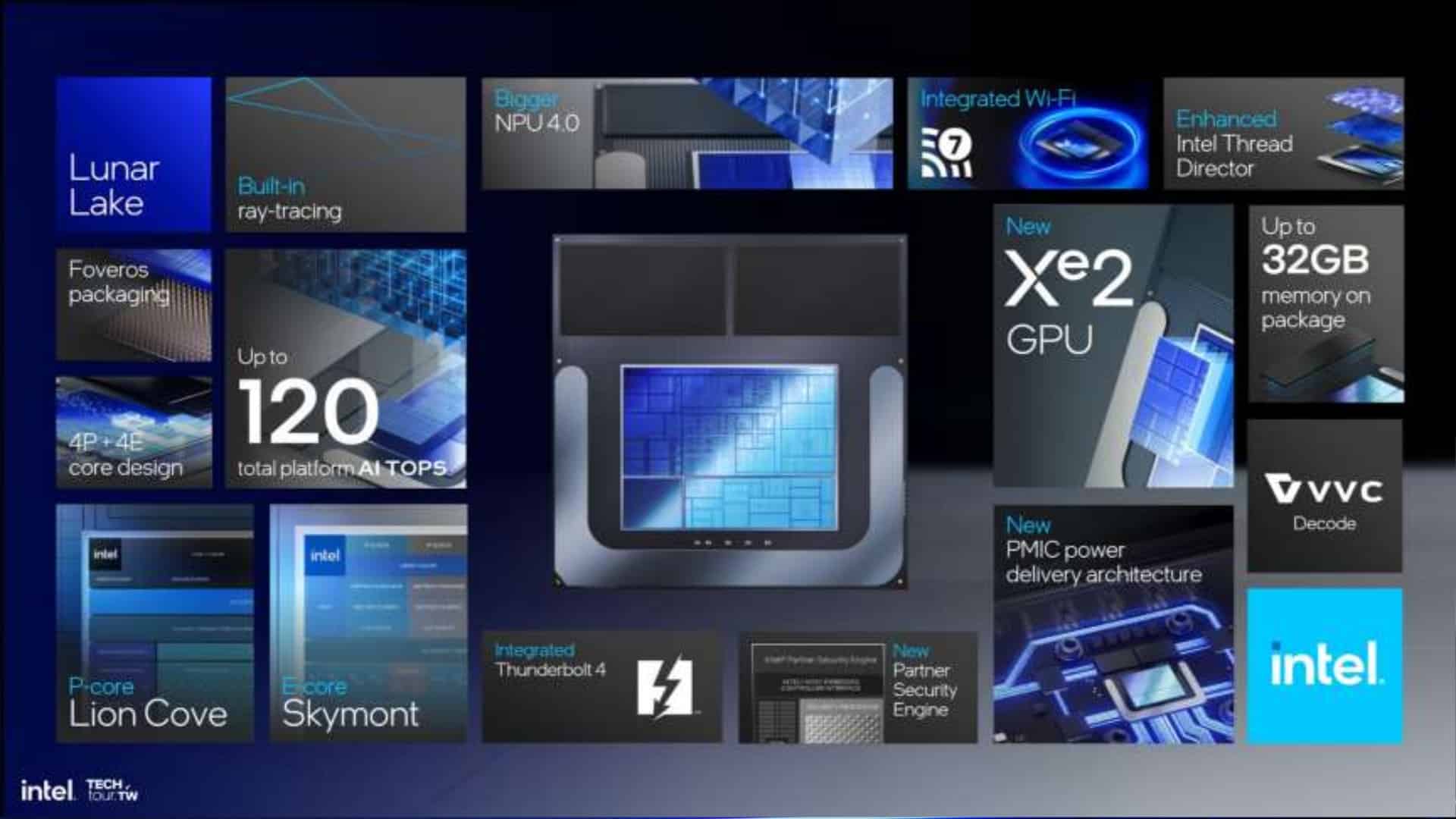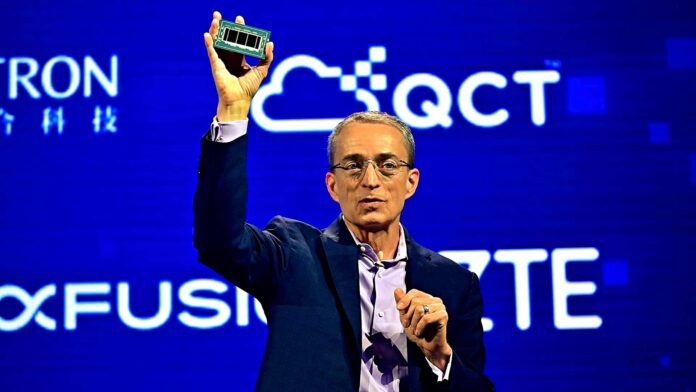Intel’s new architectures are not only exciting for the mobile segment, but also provide a preview of upcoming desktop processors and GPUs
Computex 2024 officially kicks off today in Taipei (Taiwan); numerous companies will be showcasing new products and technologies from June 4 to 7.
Both Nvidia with new AI solutions and AMD with the first Ryzen 9000 processors have already held a keynote:
As the last manufacturer from the big tech trio, Intel has now also held a large-scale presentation as part of the “Technology Tour”, focusing on the upcoming Lunar Lake architecture:
- This was not just about the pure improvements that will be made with the new mobile processors based on the previous Meteor Lake generation.
- There was also a detailed presentation on the new Xe² architecture – and therefore also on the upcoming Battlemage GPUs.
Lunar Lake: Intel’s answer to AMD, Apple and Qualcomm
AMD with theRyzen 8000 series,Apple with thevarious M3 variants, Qualcomm with theSnapdragon Elite X- Intel’s competition in the mobile segment has grown many times over in recent years.
Accordingly, Intel also sees the need for significant further development of its own processors and, in doing so, is partly drawing on lessons that its competitors have taught the undisputed chip king for years.
Table of Contents
“Memory on Package”: Intel learns from Apple
One of these lessons can be found in LPDDR5 memory, which, analogous to Apple’s approach, is no longer found on the motherboard since the M1, but is now integrated directly into the CPU housing for the first time at Intel.
- The disadvantage: As a permanently integrated part of the processor, the RAM can no longer be replaced in Lunar Lake. On the other hand, many notebook manufacturers used to solder the RAM, which made it difficult for the average customer to replace it anyway.
- The advantage(at least according to Intel): Space savings on the board itself as well as significantly lower energy consumption.
New performance and efficiency cores: Hyperthreading is no longer required
With a new generation of CPUs, Intel is also introducing new variants of performance and efficiency cores
- Intel is taking a bold step here: Hyperthreading (HTT), which has been in use for 15 years, is being removed in Lunar Lake
- The decision is also justified here with greater energy efficiency; after all, the P cores must always be active for HTT – bad for this metric, as Intel finds.
In order to compensate for the theoretical performance loss that Lunar Lake accepts due to the elimination of HTT, the IPC (instructions per clock cycle) of the P-cores called “Lion Cove” are increased.
- Compared to its direct predecessor, this should result in a plus of 14 percent .
- Basically, Intel wants to achieve the same single-thread performance with Lion Cove at half the power consumption.
The new E-Cores for Lunar Lake, which are called “Skymont“, will be exciting.
- Intel promises an increase in IPC performance of up to 68 percent compared to its predecessor. The power consumption should be reduced by a third at best.
Of course, there was also artificial intelligence to marvel at
You didn’t really think a tech company would hold a keynote these days without mentioning the word “AI” a few times
- As expected, Lunar Lake also relies on an NPU (Neural Processing Unit) that specializes in AI applications. The performance compared to Meteor Lake is expected to increase from 12 to 48 TOPS.
- In addition to the P and E cores mentioned above, there is also a revised “Thread Director“, which is intended to ensure optimal load distribution on an AI basis.
- The P cores should only be used at all above a certain utilization limit. Here, too, it becomes clear how important it is for Intel to find the most energy-efficient solution possible.
The foundation for Arrow Lake has been laid
A concrete release date for Lunar Lake and corresponding end devices was not mentioned, however. Intel only states the third quarter of 2024 as the time frame; it is therefore conceivable that such models will be released for the first time at IFA 2024 (September 6 to 10)
- A timely completion of the first production run is also eminently important for the desktop market. After all, the Arrow Lake generation planned for this year will also use some components from Lunar Lake – specifically Lion Cove and Skymont.
- Wi-Fi 7 and Bluetooth 5.3 are also on board in both cases, as are four PCIe 4.0 and four PCIe 5.0 lanes, allowing PCIe 5.0 SSDs to maximize their speed.
Intel Xe²: New GPU architecture promises 50 percent more performance
As expected, the Lunar Lake presentation also focused on the next generation of GPU architecture: Xe² will be used in both the integrated graphics unit and the dedicated Battlemage GPUs
- In principle, Intel sees Xe² as a direct further development of the previous generation. As with the CPU itself, the focus here is on greater energy efficiency.
- Practical benchmarks are not mentioned, however. Only a “plus of 50 percent compared to Meteor Lake” is listed as an indication of the performance increase.
- At least it was explained that better performance can be expected in games based on Unreal Engine 5, for example.
Raytracing performance (theoretically) increased by 33 percent
A hobbyhorse during the Intel keynote on the Xe² architecture was the performance in ray tracing scenarios
In theory, the ray tracing performance of the Xe architecture is increased by 33 percent per RT unit – of which there are four per render slice.
- We deliberately emphasize “in theory” here, as no gaming benchmarks were shown for this either.
- The calculated additional performance is again derived from three instead of two traversal pipelines in Xe², which are responsible for processing 3D models, among other things.
- This in turn results in 18 instead of 12 possible box intersection tests (e.g. for collision detectionfor light rays) and two instead of one triangle intersection test (to determine which objects are visible from the camera perspective).
A first Battlemage snapshot?
The advantages of the Xe² architecture will also be used in Battlemage – whenever the GPUs are unveiled. A first, albeit poorly recognizable snapshot of a Battlemage die is already circulating on X/Twitter:
Hi Battlemage
This is the first die shot of Battlemage discrete according to TAP pic.twitter.com/JYoXzD3dVW
– Hassan Mujtaba (@hms1193) June 4, 2024
XeSS without frame generation
By the way: As the colleagues fromComputerBasereport, apart from the Lunar Lake presentation, the topic of frame generation in games was also briefly discussed.
- A solution analogous to Fluid Motion Frames or Frame Generation will not be available from Intel, at least not in the near future.
- Intel says it sees “interesting possibilities to temporarily increase the frame rate” – but the solutions from AMD and Nvidia are apparently not among them.
- What alternatives the company sees was not specified. It is possible that this is an allusion to “ExtraSS”, which, unlike the competition, relies on extrapolation instead of interpolation:
From Wi-Fi 7 to DisplayPort 2.1, (almost) all important standards are included
For the sake of clarity, we combine here the supported connections that Intel has provided for Lunar Lake and Xe²
- As expected, Wi-Fi 7 is on board; however, the network standard still has to establish itself with the end devices. Bluetooth 5.4 is also mentioned, which also focuses on power efficiency in line with the previous objective. Up to three Thunderbolt 4 ports round off the package.
- The GPU architecture supports Displayport 2.1, which in theory also means support for 4K resolution at 240 hertz. HDMI 2.1 is also included.

Opinion from the editorial team
It’s done, the three big manufacturers around AMD, Intel and Nvidia have performed their Computex keynote. And of the three companies, Intel was actually the most exciting in my eyes. Which wasn’t particularly difficult compared to its two competitors.
Nvidia continues its AI hypetrain undeterred – RTX 5000? Not a thing. AMD at least had new processors in the bag, but the Ryzen 9000 CPUs are more likely to be seen as selective improvements to their predecessor.
Of course, that’s not a bad thing given the excellent Zen 4 architecture, but the highlight for me will only come at CES 2025 anyway, when the X3D variants are due.
Intel, on the other hand, has a duty due to the competitive situation mentioned at the beginning and at least nurtures the hope that meaningful progress will be made with regard to upcoming products – both in the mobile and later in the desktop segment; both in terms of CPUs and GPUs. More competition in a market has never hurt us as end users.


